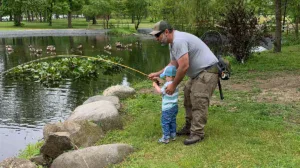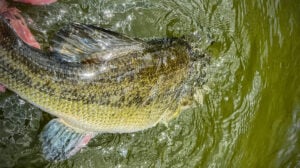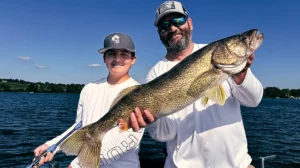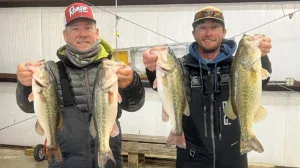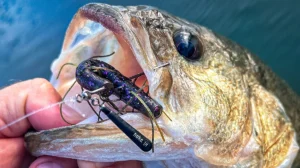Bass fishing with a tube is a technique that every angler should have in their fall arsenal. Although it’s tempting to chunk crankbaits and topwater lures in the autumn months, slowing down and picking apart cover can produce outstanding results.
Elite Series pro Kevin Hawk always has a tube nearby when fishing in the fall. According to him, it’s one of the only soft plastic baits that will catch fish in every lake under almost any conditions.
Stopping points and contour changes
Fall bass fishing is all about the shad—they migrate into the creeks and the bass follow. That doesn’t mean, however, that imitating other types of bass forage should become an afterthought. As the bass migrate to shallow water via creek channels, they’ll position themselves around strategic pieces of cover along the way.
“It seems like a lot of the bigger fish take their time getting to the backs of creeks throughout the fall months,” Hawk said. “As they work their way into the shallows, they routinely stop on small holding areas or transitions. In my experience, if
“A tube is one of those things that gets bit wherever I go in any conditions,” Hawk said. “It’s even effective during brutal cold fronts– they’ll eat this bait before most soft plastics.”
you can find any type of contour change, such as a bluff or a point, you need to be on high-alert for available cover in that area because that’s where big bass will be.”
Throughout the late fall, Hawk begins his search in the mouths of creeks. When he locates suitable cover, he believes it’s hard to beat the streamlined profile of a tube.
“A Texas rigged rube is perfect for pitching and flipping,” Hawk said. “Not only does it come through cover excellently because of its streamline profile, but it also has just the right amount of action. In cooler water, I don’t want a lot of action on my baits—when the water cools and winter approaches, I believe bass respond much better to a more subtle presentation. A soft plastic that moves all over the place just doesn’t produce as well in cold water.”
Key cover to target
Tubes can catch bass regardless of available cover but catching consistent quality requires a bit more precision. There are four types of cover that Hawk targets with a tube throughout the late fall months.
- Grass—”If I’m on a fishery that has a lot of vegetation in it, I’m going to try the grass before anything else,” Hawk said. “It can be hard to get on a consistent wood bite if there are thousands of acres of grass, so that’s where I’ll fish first. If you can find grass combined with other kinds of cover, that can be even better.”
- Laydowns—”I try to look for the thickest wood cover I can find,” Hawk said. “If I see a bunch of smaller stick-ups around a laydown with some bigger trunks nearby, I’m going to pitch a tube to those trunks before anything else. I like to look for laydowns around points and channel swings because these areas give bass quick access to both shallow and deep water. Be sure to look for laydowns on flats adjacent to channel swings or points, too; flats always play a big role in fall fishing.”
- Brush piles—”Look for brush piles in the same areas you would look for laydowns,” Hawk said. “Obviously laydowns are more visible and easier to find, but that can sometimes mean that brush piles are much less pressured. I simply graph points and contour lines until I find a brush pile in about 10 feet of water. I fish it just like a would a laydown—pulling the tube over each limb and constantly watching my line.”
- Docks—”If you find a dock with crappie lights, mounted rod holders or even fish feeders, it can be a dead giveaway to nearby brush,” Hawk said. “I like to focus on these kinds of docks near points first. I’m also going to look for any ladders or additional pieces of potential cover that protrude from the dock and pick them apart.”
Work from the inside-out
When many of us approach a piece of cover, we’ll just flip and pitch wherever we can get our baits. Hawk, however, employs a very methodical approach that allows him to cover water efficiently and avoid spooking nearby bass.
Did you know? Flipping and pitching a tube in heavy cover can be quite easy to pattern this time of year. When you get a bite, pay attention to the water depth and type of cover. Chances are, you’ll be able to cover water quickly and have a lot of opportunities at big bites.
“When I fish a laydown with a tube, I’m going to target its perimeter first so I can pick off the more aggressive fish using the cover as an ambush point for nearby bait,” Hawk said. “You don’t want to make your first pitch into the heart of the cover. If you catch one, it can spook the more accessible fish on the edges.”
Although it can vary depending upon the conditions and mood of the bass, Hawk makes about six pitches to each piece of cover before moving on.
“Big bass love to eat a tube, so it usually won’t take dozens of casts to make them bite,” Hawk said. “If you can make six quality pitches that allow you to cover the front, middle and back of the cover, you’ve fished it thoroughly.”
Effective rigging options
Hawk utilizes two different rigging methods when fishing a tube around cover. Both of the rigs give the tube a totally different look in the water.
- Tex-pose: ”I use an Owner Wide Gap Plus Hook because it allows me to Tex-pose my Yamamoto Tube,” Hawk said. “I thread the hook through the nose of the tube, bury the eye of the hook into the head of the tube, insert the hook
point into both walls of the tube and very lightly bury the point on the outside wall. It’s very snag-resistant in heavy cover, but also promotes an excellent hookup.”
- Finesse: ”Around docks, I really like to use spinning gear when fishing a tube, but I rig it differently,” Hawk said. “To get an awesome horizontal fall around vertical cover, lubricate the inside of a Yamamoto Tube with your favorite fish scent and shove a 3/16 or 1/4-ounce lead bullet weight halfway up the middle of the hollow cavity. Then simply take an Owner Wide Gap Plus Hook and Tex-pose it. This creates an extremely weedless setup that skips incredibly and doesn’t spiral on the fall like most tube rigs.”
When using a Tex-posed tube around wood cover, Hawk makes a point to peg his weight. In order to achieve an effective presentation, a straight fall to the bottom and a snag-free profile, it’s important for the weight and tube to stay in contact in heavy cover. When fishing grass, however, it’s a different story.
“I like to let my weight slide free when I’m fishing grass with a tube,” Hawk said. “You usually don’t have to pull your tube over obstructions when dragging it through grass, so weight separation becomes a non-issue. I believe a tube has a better, more natural action when fished with an unpegged weight, so I try to take advantage of that when I’m fishing around vegetation.”
Color selection and retrieve
Every bass angler has a different theory regarding soft plastic color selection. Some are big believers in different shades and fleck colors while some anglers keep things remarkably simple. Hawk doesn’t get carried away when choosing colors. He uses the same color in almost every situation.
“I’m going to throw a green pumpkin-colored tube 99 percent of the time,” Hawk said. “There’s no need to get too fancy. I believe green pumpkin is a great all-around imitation of both crawfish and bluegill. If I’m noticing large numbers of shallow bluegill around cover, I’ll definitely tip the tube’s tentacles in chartreuse to add a little realism. When the water is very muddy, I do change to a black Yamamoto Tube with blue flake so the bass can see it a little better.”
Contrary to popular belief, fishing a tube isn’t difficult. There’s no magic retrieve that works better than others—above all, it’s important to cater your retrieve to the bass’ preference. Hawk urges the importance of constant experimentation but offers three retrieves for beginning tube anglers to try.
- Slow and steady—”More often than not, I’m dragging a tube when I’m fishing around cover,” Hawk said. “You don’t want to drag it too fast because you’ll start getting more hang-ups if you rush through your retrieve. Just a slow and steady drag through the cover is an excellent retrieve to start with.”
- Pop it—“If I’m not getting any bites dragging a tube, I’ll pop it occasionally,” Hawk said. “When bass are inactive, sometimes you can spur reaction strikes by incorporating an occasional twitch or pop into your retrieve.”
- Punch your rod—”When it gets colder and winter nears, I will absolutely dead-stick a tube around cover,” Hawk said. “I’ll often times let it soak for 30 seconds before imparting any type of action. Instead of moving my rod tip, I actually hit the butt of my rod with my fist to make my line shake. This technique gives it enticing movement without really moving it out of the strike zone.”
If the reaction bait bite is beginning to slow in your area, now is an outstanding time to flip and pitch tubes into heavy cover. Knowing what to target, how to approach cover and effective rigging and retrieve options will give you a definite upper-hand against the bass when the bite turns tough.







